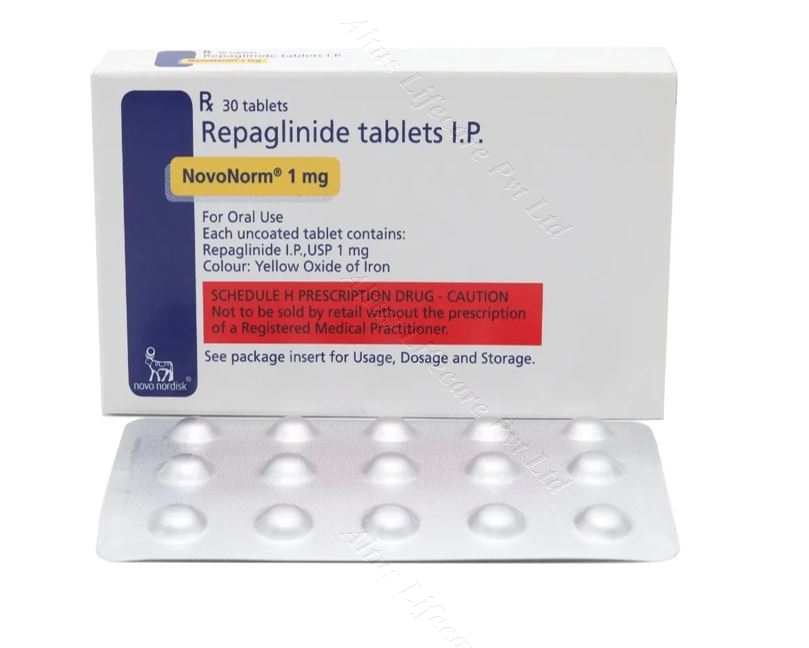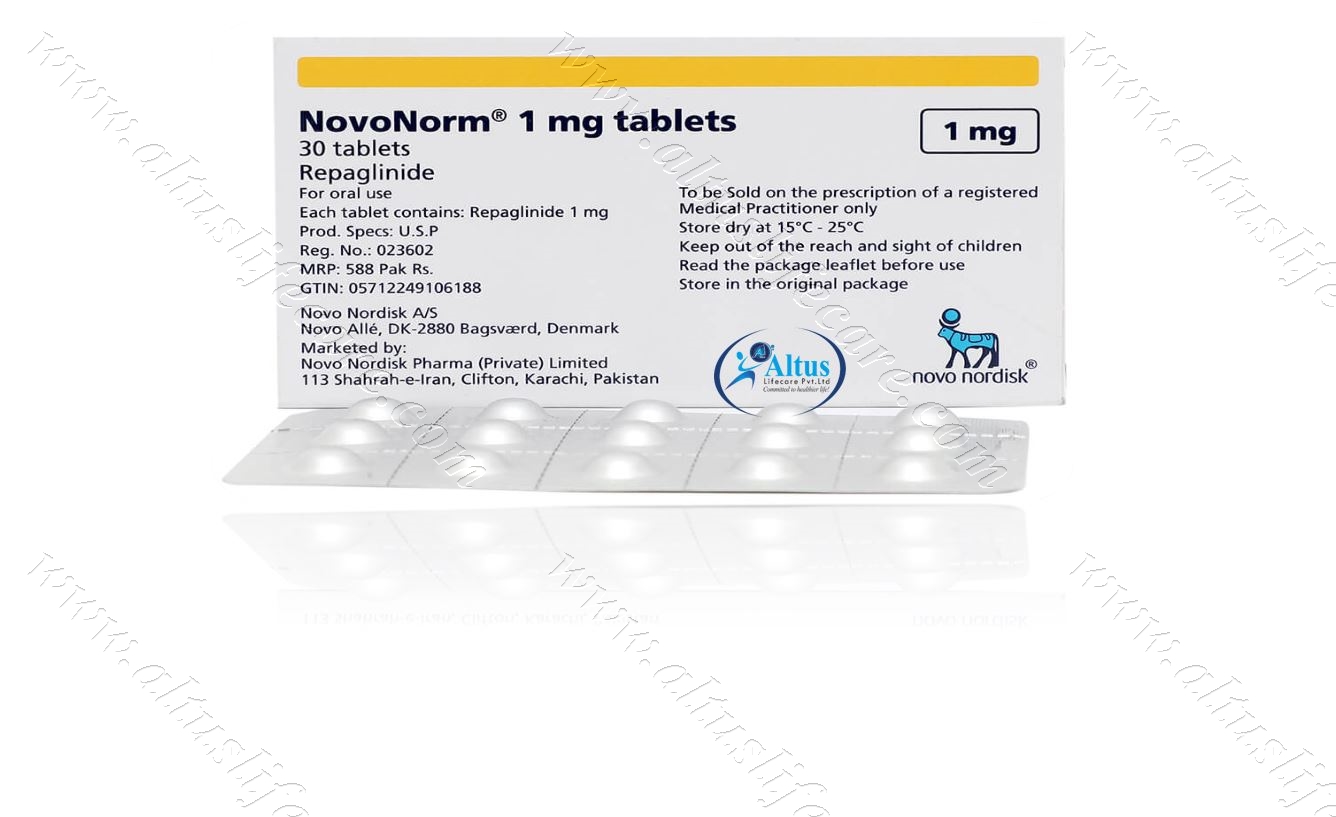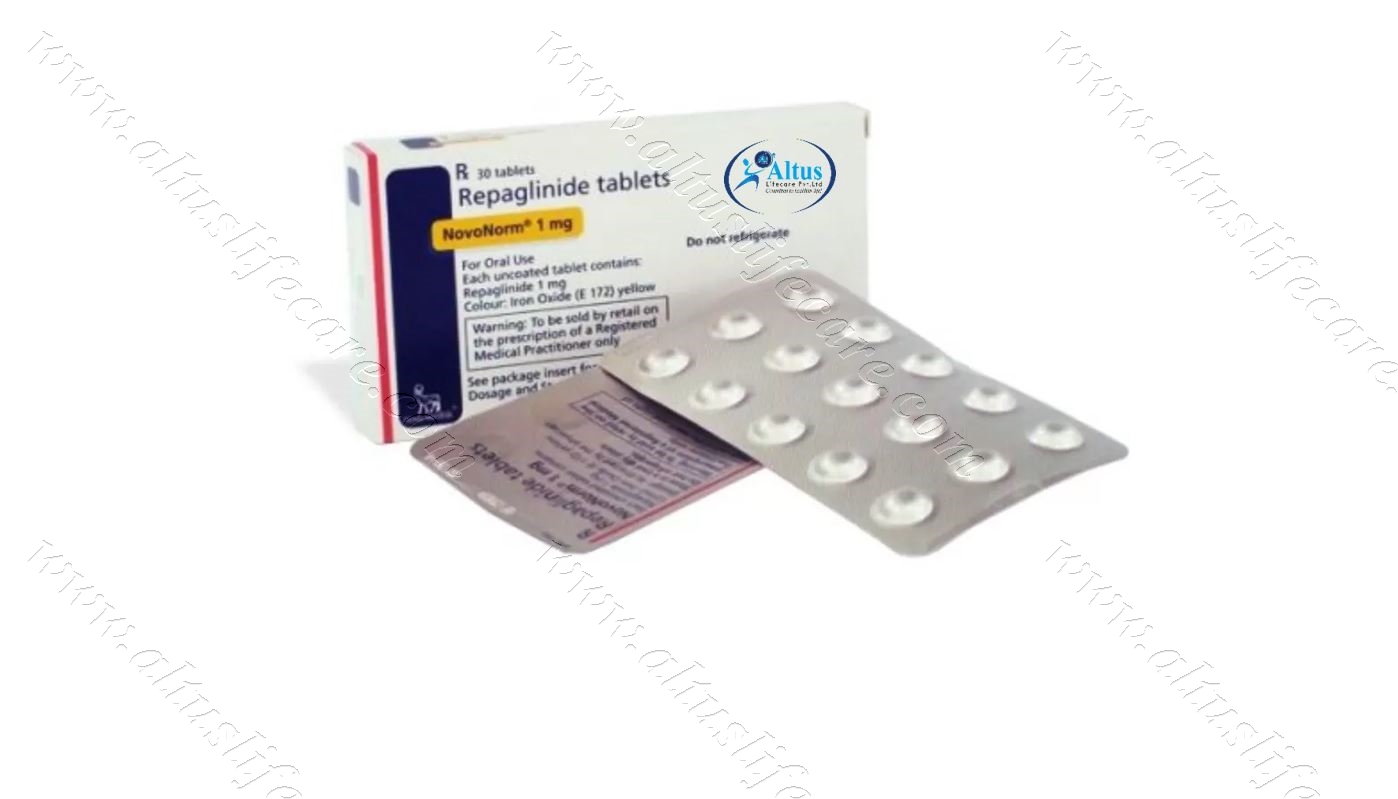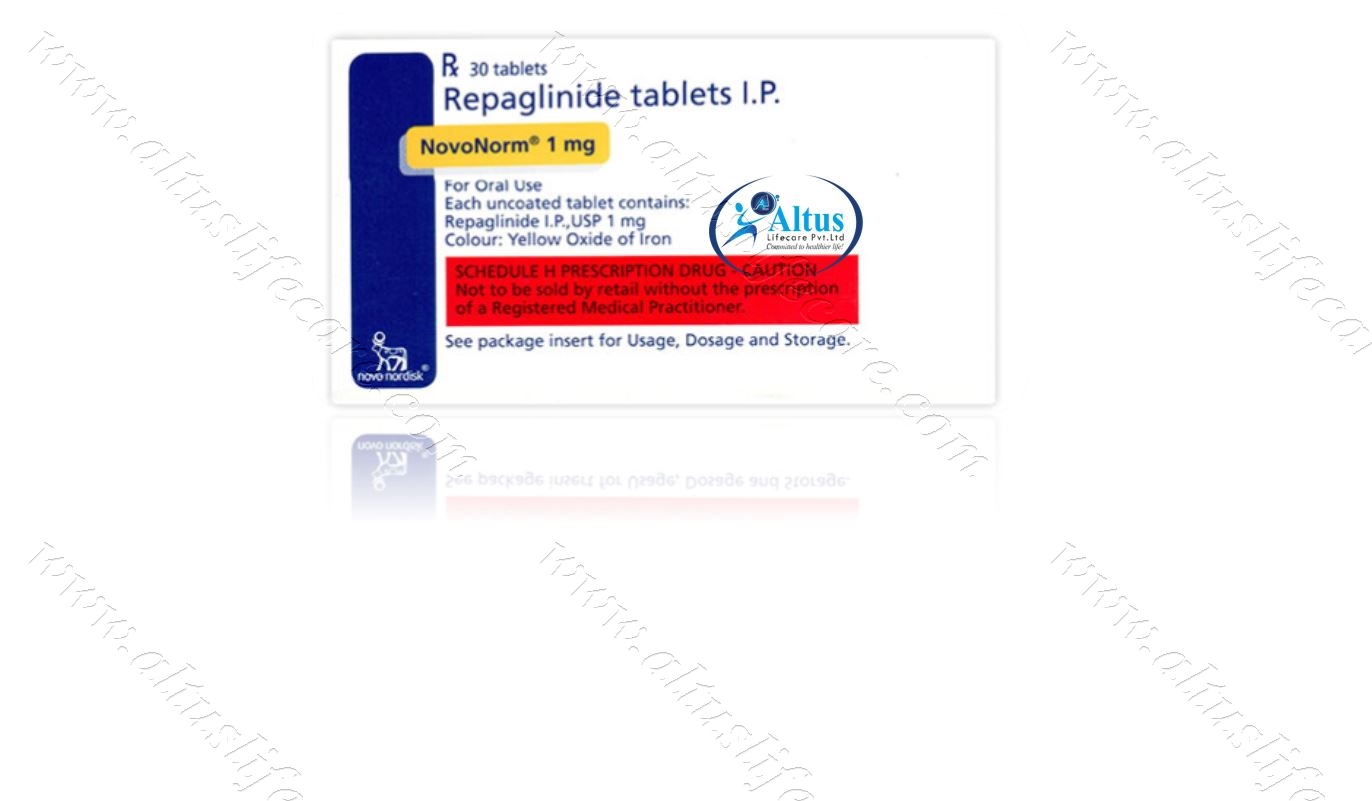Novonorm 1mg Tablet (Repaglinide (1mg)
| COUNTRY OF ORIGIN | India |
|---|---|
| DOSAGE FORM | Tablets |
| EQUIVALENT BRAND | Prandin |
| GENERIC NAME | Repaglinide |
| INDICATION | Type 2 diabetes |
| MANUFACTURER | Novo Nordisk India |
| PACKAGING | 15 tablets in 1 strip |
| COMPOSITION | Repaglinide (1mg) |
| PACK SIZE | 90 Tablet/s, 150 Tablet/s, 210 Tablet/s, 300 Tablet/s |
PRODUCT INTRODUCTION
Novonorm 1mg Tablet is used to lower blood sugar levels in adults with type 2 diabetes mellitus. It is usually prescribed along with other diabetes medicines to achieve adequate blood sugar control. It also prevents serious complications of diabetes like kidney damage and blindness.
It is normally prescribed when diet and exercise alone or other medicines have not been enough to control your blood sugar level. It works best when taken before meals. The dose will depend on your condition, and blood sugar levels, but you should take it as advised by your doctor.
Take Novonorm 1mg Tablet regularly, at the same time each day, to get the most benefit and you should not stop unless your doctor recommends it.
It is controlling your blood sugar levels and helping to prevent serious complications in the future. It is important to stay on the diet and exercise program recommended by your doctor while taking this medicine. Your lifestyle plays a big part in controlling diabetes.
The most common side effect of taking this medicine is hypoglycemia (low blood sugar levels). You can carry sugar or glucose candy to control low blood sugar levels. Other common side effects that may be seen while taking this medicine include abdominal pain and diarrhea. Contact your doctor if the side effects worry you or if they do not go away.
Before taking this medicine, let your doctor know if you have ever had kidney disease, heart or pancreas problems, or if you drink a lot of alcohol. Pregnant or breastfeeding women should also consult their doctor before taking it.
Some other medicines you are taking may interfere with it so make sure your doctor knows about all the other medicines you are taking. Limit your alcohol intake while taking this medicine because it can increase your risk of developing low blood sugar levels. You may need regular tests such as kidney function and blood glucose levels to check that the medicine is working properly.
“Repaglinide Class Dynamics: A Contemporary Perspective on Therapeutic Progress”
Gain a contemporary perspective on Repaglinide class dynamics, exploring the latest therapeutic progress that distinguishes it in the field of diabetes care. From rapid onset of action to favorable side effect profiles, medications within this class contribute to a progressive shift in the approach to managing diabetes.
“Repaglinide Tablet Efficacy: Unraveling the Mechanisms of Rapid Glucose Regulation”
Unravel the mechanisms behind Repaglinide Tablet efficacy, particularly in the realm of rapid glucose regulation. This exploration provides insights into how these tablets leverage their unique properties to swiftly and effectively address fluctuating blood sugar levels.
Unveiling Repaglinide: Mechanism of Action and Glycemic Control
This heading focuses on elucidating the intricate mechanisms through which Repaglinide operates in the body. It explores how Repaglinide, as a meglitinide class medication, stimulates the pancreas to release insulin.
By understanding the medication’s mechanism of action, individuals can gain insights into how Repaglinide aids in glycemic control, contributing to the regulation of blood sugar levels in those with type 2 diabetes.
Repaglinide, belonging to the meglitinide class, facilitates insulin release from the pancreatic beta cells. Unlike some other antidiabetic medications, Repaglinide primarily acts on postprandial glucose levels, making it particularly effective in managing blood sugar spikes after meals.
By comprehending this mechanism of action, patients and healthcare providers can better appreciate how Repaglinide plays a crucial role in maintaining optimal glycemic control.
Signs and Symptoms of Type 2 Diabetes Mellitus: Unmasking the Silent Diabetes Onset
Unmask the silent onset of diabetes by exploring the specific signs and symptoms associated with Type 2 Diabetes Mellitus. Understand the subtleties of these silent indicators and their significance in recognizing diabetes in its early stages.
Medications for Diabetes Mellitus Type 2: Navigating Treatment Paths
Navigating the treatment landscape of type 2 diabetes involves exploring various paths, and medications are essential components of this journey. In this blog, we’ll discuss different treatment paths and how medications can play a key role in each one.
“Meds for Diabetes Mellitus Type 2: Medication Strategies for a Healthier Tomorrow”
Explore strategic medication approaches for paving the way to a healthier tomorrow for individuals managing Type 2 Diabetes. This guide delves into how specific medication strategies can be employed to contribute to long-term health goals and overall well-being.
Treatment of Type 2 Diabetes Mellitus: The Influence of Cultural Competence in Diabetes Care
Recognizing the importance of cultural competence, this section explores the influence of cultural considerations in the treatment of Type 2 Diabetes Mellitus. By addressing diverse cultural perspectives, the discussion aims to promote inclusive and patient-centered diabetes care.
Crafting Hope: Drug for Diabetes Mellitus Type 2 Chronicles
Exploring the drug’s role in crafting a sense of hope for individuals with Diabetes Mellitus Type 2, this discussion discusses how it contributes to a positive outlook and an optimistic health journey.
Diabetes Mellitus Medications: Medication Choices for Comprehensive Diabetes Care
Explore the array of medication choices available for comprehensive diabetes care. This guide provides insights into selecting medications that address various aspects of diabetes, contributing to a well-rounded care approach.
DM Type 2 Medications: Medication Mastery and Lifestyle Synergy
Achieve medication mastery with a focus on synergizing medications with lifestyle choices for individuals managing Type 2 Diabetes. Explore how this synergy contributes to an integrated and balanced way of living.
USES OF NOVONORM TABLET
- Treatment of Type 2 diabetes mellitus
BENEFITS OF NOVONORM TABLET
In Treatment of Type 2 diabetes mellitus
It is increases the amount of insulin your body produces (in the pancreas). The insulin then works to lower your blood glucose levels and prevents them from rising after taking meals. You should keep taking it for as long as it is prescribed.
Lowering blood glucose levels is an essential part of managing diabetes. If you can control the level you will reduce the risk of getting any of the serious complications of diabetes such as kidney damage, eye damage, nerve problems, and loss of limbs. Taking this medicine regularly along with proper diet and exercise will help you live a normal, healthy life.
SIDE EFFECTS OF NOVONORM TABLET
Common side effects of Novonorm
- Upper respiratory tract infection
- Headache
- Hypoglycemia (low blood glucose level)
HOW TO USE NOVONORM TABLET
HOW NOVONORM TABLET WORKS
SAFETY ADVICE

Alcohol

Pregnancy

Breast feeding

Driving

Kidney

Liver
Use of Novonorm 1 mg Tablet is not recommended in patients with severe liver disease.


























Vanessa (verified owner) –
I’ve embraced the role of an educator, sharing insights about type 2 diabetes to promote awareness and understanding.
Ensley (verified owner) –
“The quality is exceptional, and the shipping was surprisingly quick!”
Laylah (verified owner) –
“The product’s quality is unmatched. The packaging was so well thought out, ensuring that it arrived in perfect condition.”